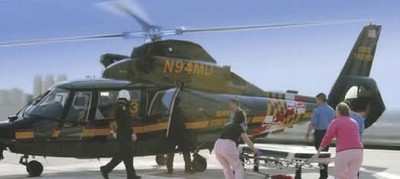Several Officials Question Dependence On Helicopters
 In what could be a major step
backwards for helicopter medevac operations, a panel of emergency
medical officials met last week in Maryland to review the state of
operations following the September 28 loss of a Eurocopter AS365
Dauphin II in poor weather conditions.
In what could be a major step
backwards for helicopter medevac operations, a panel of emergency
medical officials met last week in Maryland to review the state of
operations following the September 28 loss of a Eurocopter AS365
Dauphin II in poor weather conditions.
The Baltimore Sun reports a number of panelists expressed
concern that local EMS operations may rely too much on helicopters
to transport accident victims, adding several ambulance crews may
now be reluctant to dispatch crews and patients onboard medevac
helos.
"I'm concerned right now that there are some patients that
should be flown to trauma centers that are not," said Dr. Douglas
J. Floccare, director of aeromedical operations in Maryland.
"There's some skittishness out there."
As ANN reported, three crewmembers and a
patient were lost in the September accident, which occurred as the
Dauphin was on approach to land at Andrews Air Force Base following
a weather-related diversion. A second patient onboard the
helicopter survived the crash.
At the core of helicopter medical evacuation policy in Maryland
is the concept of the "golden hour" -- that accident victims stand
a far better chance of surviving their injuries if transported to
trauma centers within a hour of their injuries. The dictum --
coined by Shock Trauma founder R Adams Cowley -- was questioned by
one trauma surgeon during the November 24 conference, who noted the
oft-repeated phrase has never been scientifically proven.
"I know that time is easy to quantify... However, I think it is
naive to think in 2008 that the value of helicopter transport is
time-based," said Vanderbilt University trauma surgeon John A.
Morris Jr. "The value of helicopter transport nationally is
quality-of-care based."
Panelist Bryan Bledsoe, a Nevada physician, presented his
published studies that cast doubts on whether helicopters are able
to transport patients much faster than ground-based ambulances, and
are able to save more lives.
Criticism was levied at both sides of the issue. A recording was
played at the conference, of a dispatcher telling the September 28
accident pilot that ambulance drivers "never want to drive to the
hospital." That comment has led to a national debate over how local
medical services use their helicopters, the Sun reports.

Maryland EMS officials have already made a significant change to
procedures since the September crash. Ambulance crews must now
consult with a hospital before calling for a helicopter, if
patients show no outward sign of injury. Before now, ambulance
crews could call for a helicopter on their own, based on the
likelihood of internal injuries.
Some question whether that step back has gone too far. EMS
director Dr. Robert Bass told the panel 226 patients have been
flown to the state's trauma hospitals since the accident, a pace of
about 1,680 a year. That trend is less than half the over 4,100
patients flown by Maryland EMS in 2007.
 Classic Aero-TV: In Praise of Alabamas Patriot Aircraft USA
Classic Aero-TV: In Praise of Alabamas Patriot Aircraft USA NTSB Final Report: Cirrus Design Corp SR22
NTSB Final Report: Cirrus Design Corp SR22 ANN's Daily Aero-Term (12.21.25): Dead Reckoning
ANN's Daily Aero-Term (12.21.25): Dead Reckoning ANN's Daily Aero-Linx (12.21.25)
ANN's Daily Aero-Linx (12.21.25) Aero-News: Quote of the Day (12.21.25)
Aero-News: Quote of the Day (12.21.25)




